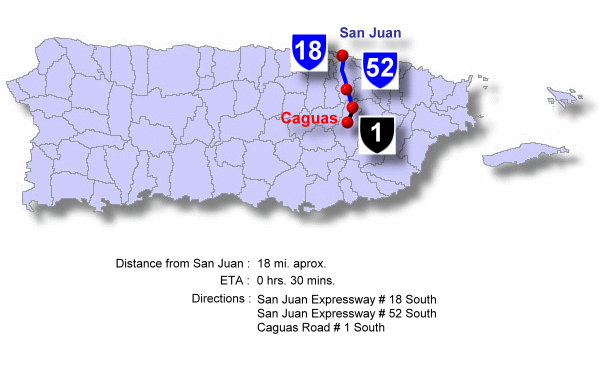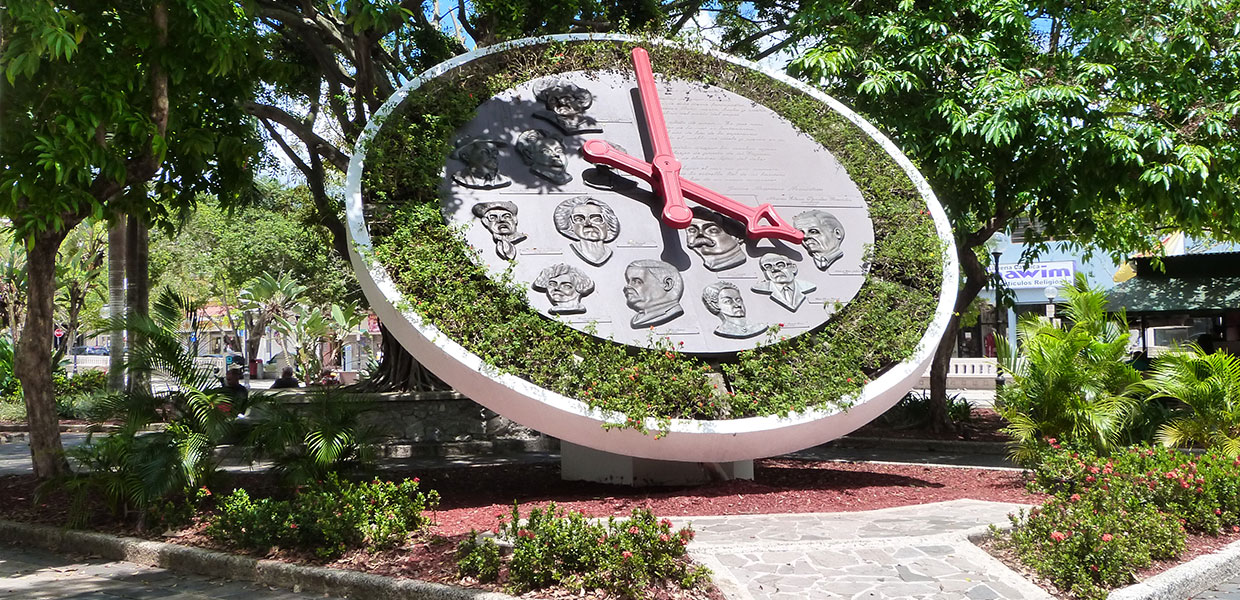
Caguas, Puerto Rico
City of the Turabo

Caguas (KAH-gwahs) is known as the “City of the Turabo” because it is spread out along the Turabo River valley. The city is also known as “the criollo city” or “the heart of Boriquén”. The festivities are celebrated near December 24 in honor of the Sweet Name of Jesus.
The municipality is located in the central eastern part of the island in the geographical subregion called the Caguas or the Turabo River valley. It is bordered on the north by San Juan and Trujillo Alto; on the south by Cayey and San Lorenzo; on the east by Gurabo and San Lorenzo; and on the west by Aguas Buenas, Cidra and Cayey.
The climate is a humid tropical climate, although there is less rain than in the eastern coastal valleys. The land, however, is fertile and deep.
Today Caguas is a major industrial and commercial center with more that 40 factories where plastic, clothing, leather goods, tobacco products, cameras, electronics, and other articles are manufactured. The city also is a tourist and ecological center, notably having inaugurated a botanical and cultural garden, part of the revitalization program for the traditional town center, where there are several sites and museums of interest for visitors.
Foundation:
Originally known as San Sebastián del Piñal de Caguax. The name is derived from the Indian Chief Caguax, a legendary Indian chief who reigned in these lands during the decline of the Taino civilization and faced the Spanish conquerors with brave resistance. Soon after he turned to Christianity.
Caguas was founded in 1775. In 1820 it received the title of Villa and in 1894 the title of City. Once Caguas became a municipality, housing improved and the streets were widened.
Location:
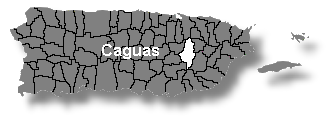 Caguas is located at the eastern end of the Central Mountain Range (Cordillera Central) surrounded by the Cayey Sierra. It is bordered by: Guaynabo, San Juan and Trujillo Alto on the north, Cayey and San Lorenzo on the south, Aguas Buenas, Cidra and Cayey on the west, and Gurabo and San Lorenzo on the east.
Caguas is located at the eastern end of the Central Mountain Range (Cordillera Central) surrounded by the Cayey Sierra. It is bordered by: Guaynabo, San Juan and Trujillo Alto on the north, Cayey and San Lorenzo on the south, Aguas Buenas, Cidra and Cayey on the west, and Gurabo and San Lorenzo on the east.
Area:
147.1 sq km / 58.6 sq mi
Population:
140,502 (census 2000)
Population Density:
955.1 per sq km / 2,397.6 per sq mi
People are known as:
Cagüeños
Caguas is also known as:
La Ciudad del Turabo (City of The Turabo)
El Corazón de Boriquén (Boriquén’s Heart)
La Ciudad Criolla (The Criole City)
Caguas, Puerto Rico

| Census 2000: Population by Wards – Caguas | Habitants |
| Bairoa | 19,201 |
| Beatriz | 4,467 |
| Borinquen | 6,522 |
| Caguas (city) | 24,023 |
| Cañabón | 6,070 |
| Cañaboncito | 28,669 |
| Río Cañas | 10,982 |
| San Antonio | 2,395 |
| San Salvador | 3,272 |
| Tomás de Castro | 19,301 |
| Turabo | 15,600 |
| Total | 140,502 |
Información: Negociado del Censo de los EE.UU. Censo 2000
Patron:
Dulce Nombre de Jesús
Dulce Nombre de Jesús Cathedral
Apartado 967
Caguas, P.R. 00726
Tel. (787) 743-4311
Fundation: March 1915
Mass Schedule:
Daily: 6:15am, 7:00am & 6:30pm
Saturdays: 7:3Opm | Sundays: 7:30am & 10:00am
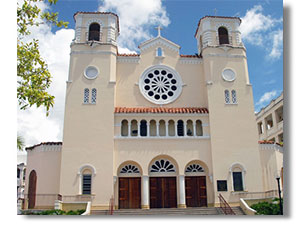
Topography:
Its territory extends thru the Valley of Caguas or El Turabo, between the Sierra de Cayey and ramparts of the Central Mountain Range (Cordillera Central). The highest elevations are the Lucero at 2,887 feet, Alto de la Mesa at 1,210 feet, and the Los Altos de San Luis at 886 feet.
Hydrography:
The Grande de Loíza river divides this municipality from Gurabo. The Turabo, Cagüitas, Cañaboncito, Bairoa and Cañas rivers also form part of its hydrography.
Economy:
The economic activities of the city include: diamond cutting, tobacco, manufacture of leather products, crystal and plastic, electronic equipment and clothing.
Average Salary:
$292.01 weekly (1998)
Flag:
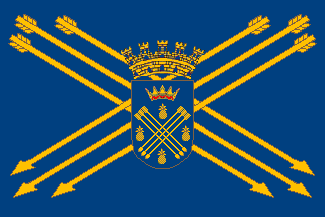 The flag was adopted in 1960. The colors are blue and yellow. The cross stands for the Cross of San Sebastián, for this was the first Christian village that settled in the Caguas Valley together with the hermitage of San Sebastián del Barrero.
The flag was adopted in 1960. The colors are blue and yellow. The cross stands for the Cross of San Sebastián, for this was the first Christian village that settled in the Caguas Valley together with the hermitage of San Sebastián del Barrero.
Caguas is the first Municipality to have an official flag for ten of its “Barrios” or rural communities. The flag was designed following the same blueprint as the city flag, but white instead of dark blue. The Bairoa Coat of Arms replaces Caguas Coat of Arms. It reads: “Bairoa, Clear River Water, 1842”.
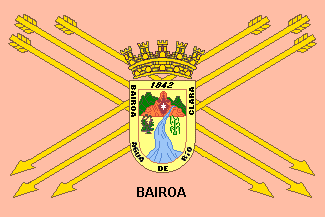 This flag was with its original white field. It was recently changed to light peach. The shield was designed by Wilma Román Torres based on the history of the Bairoa sector. The symbols and their meanings are as follows:
This flag was with its original white field. It was recently changed to light peach. The shield was designed by Wilma Román Torres based on the history of the Bairoa sector. The symbols and their meanings are as follows:
- 1842 – year of the first document identifying Bairoa as a “Barrio” · Bairoa – means “clear river water”
- Mountains – represents the mountains that surround the valley
- Cemí (Indian idol) – represents our Taíno roots and the fertility of the valley
- Carmelite Shield – represents the arrival at the sector of the Catholic faith on 1869 9
- River – represents the Bairoa river that gives origin to its name
- Tobacco plant – represents the major produce in the barrio
- Sugar Cane – represents the produce of muscovado sugar and rum of the barrio.
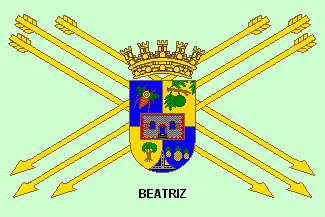 The flag was designed by Carlos I. Fernández Velázquez and its background color is “seafoam”, a kind of light turquoise or blue green. Six sectors make up the barrio and are represented in its symbology: La bandera fue diseñada por Carlos I. Fernández Velázquez y el color de su fondo es “seafoam”, una clase de turquesa clara o verde azul. Seis sectores forman el barrio y se representan en sus símbolos:
The flag was designed by Carlos I. Fernández Velázquez and its background color is “seafoam”, a kind of light turquoise or blue green. Six sectors make up the barrio and are represented in its symbology: La bandera fue diseñada por Carlos I. Fernández Velázquez y el color de su fondo es “seafoam”, una clase de turquesa clara o verde azul. Seis sectores forman el barrio y se representan en sus símbolos:
- Bees – stands for Las Abejas sector, where many beehives could once be found s
- Pana fruit – stands for Los Panes sector, a very abundant produce
- Mango tree – stands for La Jurado or El Mangó sector. Jurado was the last name of the first inhabitants; a mango tree has been for many generations at the barrio entrance
- House – stands for Luis Munoz Grillo sector, who donated his house for the still operating school ia
- Pineapples – stands for Las Pinas sector, which also was once a major produce
- Crossroad – stands for Las Cruces sector that divides the road to Caguas, Cayey and Cidra municipalities
 The flag was designed by the student Armando Sosa Flores and its background color is “blue flower”, a kind of very light blue. Its simple symbology is as follows:
The flag was designed by the student Armando Sosa Flores and its background color is “blue flower”, a kind of very light blue. Its simple symbology is as follows:
- Cemí (Indian idol) – represents the same object found at the El Algodón Farm near the Turabo riverbank
- Indian hamlets – represents the “Yucayeque” or main indian settlement that is believed existed in this place
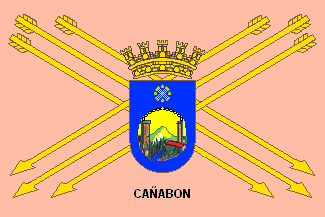 The flag was designed by the student Carlos E. Acevedo Rivera and its background color is light peach. Its symbology is as follows: Forming a circle, the symbols that stand for the historic come about of Canabón barrio appear in the center of the shield. A small Caguas city shield (crossed arrows with pineapples) appears over the main circle.
The flag was designed by the student Carlos E. Acevedo Rivera and its background color is light peach. Its symbology is as follows: Forming a circle, the symbols that stand for the historic come about of Canabón barrio appear in the center of the shield. A small Caguas city shield (crossed arrows with pineapples) appears over the main circle.
- Broken chain – the abolition of black slavery in 1873
- Cemí – in the background appearing as a mountain (it is de facto believed that the designed of these stone idols was inspired by the actual form of our mountains), meaning the native indian contribution to the area development. In the present, the development as a botanic garden of the area known as Las Casitas is been considered
- Chimney – the right side one represents the San José Sugar Mill and the left side one represents the Santa Catalina Sugar Mill. Both of them are surrounded by a sugar cane plantation and the birth of the Cagüitas river.
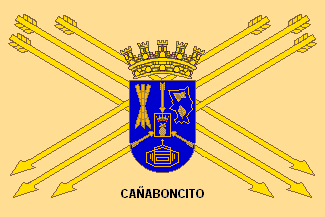 The flag was designed by Norma I. Villafane Semidey and its background color is “buff”, a kind of yellow cream color. Its symbology is described as follows:
The flag was designed by Norma I. Villafane Semidey and its background color is “buff”, a kind of yellow cream color. Its symbology is described as follows:
- The blue, red and gold colors – represents the City of Caguas
- Crown – represents the “Cacique” or chief Caguax
- Pineapple – represents the Settlement of El Pinal, as the city was first known
- Rectangle – stands also for the city of Caguas
- Arrows – our native weapons
- Three sugar canes – stands for “good sugar cane” that gives name to the barrio
- Map – geographic depiction of the barrio
- Cow – represents the live stock industry
- Tobacco leaf – represents the tobacco industry
- Church – represents Christianity and brotherhood
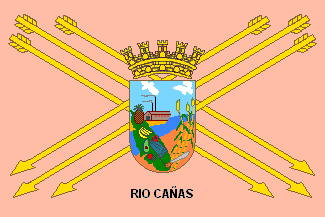 The flag was designed by Lydia Milano Albino and its background color is light peach. Its symbology is as follows:
The flag was designed by Lydia Milano Albino and its background color is light peach. Its symbology is as follows:
- Blue, green and earthen colors – associated with nature
- Sugar Mill – symbolizes the center of the main economic activity
- Sugar cane – meant once the worker’s sustenance and dedication
- River – its waters represent the symbol that gives its name to the barrio, due to the abundance in the zone of bodies of water
- Pineapple – makes us remember the origins of our city of Caguas, the city of the Turabo (river), when the Settlement of San Sebastián del Pinal (place of pineapples) was founded in 1750
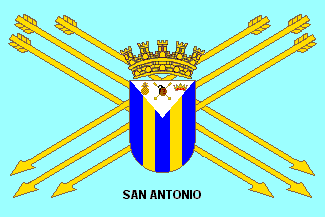 The flag was designed by the student Katerina B. Torres Figueroa and its background color is “blue flower”, a kind of very light blue. Its symbology is very simple:
The flag was designed by the student Katerina B. Torres Figueroa and its background color is “blue flower”, a kind of very light blue. Its symbology is very simple:
- The brilliant blue and gold colors – stand for the sky and the countryside, respectively
- The crown, pineapple and Indian (with crossed arrows) – are the elements present in the coat of arms of Caguas and stand for the same meaning
 The flag was designed by the student Milaniza Montalvo García and its background color is light peach. Its symbology is as follows:
The flag was designed by the student Milaniza Montalvo García and its background color is light peach. Its symbology is as follows:
- Blue background – the pluvial resources that exist and the fresh water to drink
- The river, sky and mountains – suggest Paradise, because this barrio keeps its natural resources away from the destruction that comes from cement building and technology
- Plantain or banana trees – stand for the abundance of these produce
- Olive leaves garland – stands for peace, which is abundant in the barrio, and for hope of better days
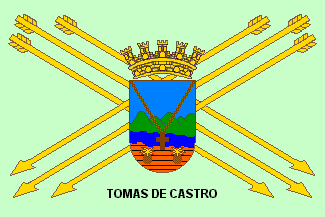 This is the flag of the rural community or “barrio” of Tomás de Castro, Caguas, Puerto Rico. This was the second community to have its own official flag after Bairoa.
This is the flag of the rural community or “barrio” of Tomás de Castro, Caguas, Puerto Rico. This was the second community to have its own official flag after Bairoa.
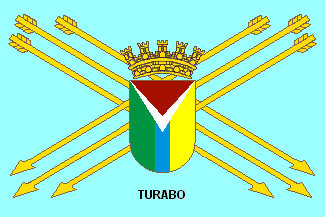 This is the new official flag of Barrio Turabo, Caguas, Puerto Rico approved by the Assembly and the Municipality of Caguas. The background color of the flag is a ligth blue with the original Turabo flag centered in a shield over crossed with the Taino’s arrows, same as the Caguas flag.
This is the new official flag of Barrio Turabo, Caguas, Puerto Rico approved by the Assembly and the Municipality of Caguas. The background color of the flag is a ligth blue with the original Turabo flag centered in a shield over crossed with the Taino’s arrows, same as the Caguas flag.
Description: The orange color of the first triangle on the flag represents the “clay” of the valley of Turabo in Caguas, Puerto Rico and symbolizes the original name of the first settlement “San Sebasti’an del Barrero”
- The arrow tip of the white triangle symbolizes the “Cacique Caguax” (Taíno Indian Chief) of the valley of Turabo, Caguas, Puerto Rico.
- The wide yellow band represents the light of the sun, the industry and the urban zone of the ward.
- The narrow blue band symbolizes the Turabo River (and also represents the blue field of the Caguas flag).
- The wide green band represent the mountains and the rural zone of the community, and the hope in the future.
- The yellow and white colors symbolize the faith and the harmony of the inhabitants of the “barrio” (ward) community.
Coat Of Arms:
 The colors blue and gold were chosen for the shield, distinctive of the city of Caguas. The figures symbolize the Indigenous and Christian origins of this city. The crown represents Chief Caguax, Monarch of the Turabo Valley, upon the arrival of the Spanish conquerors. It symbolizes in addition, the Indian village host of the Chief whose name perpetuates the city.
The colors blue and gold were chosen for the shield, distinctive of the city of Caguas. The figures symbolize the Indigenous and Christian origins of this city. The crown represents Chief Caguax, Monarch of the Turabo Valley, upon the arrival of the Spanish conquerors. It symbolizes in addition, the Indian village host of the Chief whose name perpetuates the city.
The arrows, offensive arms of the indians, are arranged in vanes or cross of San Andrés remembering the conversion to Christianity of Chief Caguax. The population of Indians under the reign of Chief Caguax lived during the sixteenth century in the western margin of the Río Grande de Loíza and probably constituted the nucleus of the Dulce Nombre de Jesús del Piñal village, second Christian population of the Valley. San Sebastián, patron of the Hermitage del Barrero, is represented by the arrows that were the instruments of his martyrdom.
The pineapples symbolize the Dulce Nombre de Jesús del Piñal village, whose neighbors moved from the place that they occupied in the eastern margin of the Río Grande de Loíza, founding the “village” of Caguas in 1775. It was constituted as a town in 1779, a named village in 1820, and given the title of city in 1894.
Events:
- Three Kings Festival – January
- Rosario cantado (sung rosary) for the Kings – January
- Beatriz Criollo Fair – February
- Borinquen Criollo Fair – March
- Cañabón Criollo Fair – April
- Festival of the Holy Cross – May
- Criollo Festival – June
- Concert and lighting of the Christmas tree – November
Places To Visit:
- Víctor Torres Lizardi Amphitheater
- Santa Catalina Plantation
- Jorge F. Sotomayor del Toro Natural Protected Reserve
- Biennial of Concrete Sculpture
- Home of the composer Héctor Flores Osuna
- Casa Rosada (Abelardo Díaz Alfaro)
- Casa del Trovador Luis Miranda “Pico de Oro”
- Sweet Name of Jesus Cathedral
- Angel O. Berrios Center for the Arts
- José Ignacio Quintón Criollo Music Center
- Eco-Plaza Borinquen
- José Gautier Benítez School
- Cofresí Plantation
- Hacienda Country Club
- Caguas Botanical and Cultural Garden (Hacienda San José)
- Monument to Luis Muñoz Marín
- Monument to Ramón Emeterio Betances
- Monument to Indigenous Women
- Monument to Puerto Rican Soldiers
- Monument to African Heritage
- Caguas Art Museum (Dr. Concha Meléndez “Casa Amarilla”)
- Carlos Manuel (Charlie) Rodríguez Museum
- Caguas Museum (at City Hall)
- Tobacco Museum (Herminio Torres Grillo)
- Caguas Tourism Office (Solá Building where the newspaper La Democracia was published)
- La Asturiana bakery
- Yldefonso Solá Morales baseball park
- Honor al Río Promenade
- Michael A. Marrero Félix Young People’s Square
- Juan Corujo Collazo Square
- Santiago R. Palmer Square (town square)
- Alcázar Theater
- Luis M. Arcelay theater
- The Telegraph Building (Former Spanish government building)
- Turabo Park
- Villa Coquí
Distinguished Citizens:
- Margot Arce de Vázquez – educator and essayist.
- Eugenio Astol Busatti – journalist, poet, short-story writer, and essayist.
- Abelardo Díaz Alfaro – short-story writer, author of El Josco.
- José Gautier Benítez – poet, author of Ausencia.
- Concha Meléndez – literary critic, essayist, and educator.
- José Mercado – poet, journalist, and humorist.
- Juan José Osuna – educator and essayist.
- Carlos Manuel (Charlie) Rodríguez – first Puerto Rican to be beatified.
- Luis Felipe (La Voz) Rodríguez Quiñones – singer
- Yldefonso Solá Morales – Mayor of Caguas (1929 – 1930), senator (1949 – 1969) and delegate to the Constitutional Assembly of the Commonwealth of Puerto Rico.
- José Ignacio Quintón – pianist and composer.
- Francisco P. Jiménez – poet and journalist.
- Héctor Flores Osuna – composer
Public Schools sorted by educational levels.
Updated: 08/07/2003
Caguas Region
Caguas I District
| Name | Level | Telephone | Address |
| Elementary | |||
| ABELARDO DÍAZ MORALES | K-6 | (787) 743-9056 | CALL BOX 4952 SUITE 353, P.R. 00726-4952 |
| AMALIA H MANGUAL | K-6 | (787) 747-1311 | PO Box 4956, P.R. 00726-4956 |
| ANDRÉS GONZÁLEZ | K-6 | (787) 747-7282 | HC 2 BOX 30830, P.R. 00726-0000 |
| ANTONIO LONGO | K-3 | (787) 747-9190 | PO Box 49552 CONSOLIDATED MALL, P.R. 00726-4952 |
| BENITA GONZÁLEZ QUIÑÓNEZ | K-6 | (787) 743-4467 | PO Box 9177, P.R. 00726-9177 |
| DIEGO VÁZQUEZ | K-6 | (787) 743-3695 | PO Box 4956 SUITE 1271, P.R. 00726-4956 |
| FRANCISCO VALDES | K-6 | (787) 747-9464 | PO Box 4956, P.R. 00726-4956 |
| JARDINES DE CAGUAS | EE | (787) 745-4110 | PO Box 4961 SUITE 149, P.R. 00726-4961 |
| JESÚS T PIÑERO | K-6 | (787) 747-1992 | PO Box 1542, P.R. 00726-1542 |
| LUIS CARTAGENA NIEVES | PK-6 | (787) 744-6961 | PO Box 4960, P.R. 00726-4960 |
| MARIA MONTAÑEZ GÓMEZ | K-6 | (787) 747-8080 | PO Box 5475, P.R. 00726-5475 |
| MIGUEL F CHIQUES | K-6 | (787) 743-2460 | URB MARIOLGA SUITE 32281 S1 AVE LUIS MUÑOZ MARÍNPR 00725-0000 |
| NEREIDA ALICEA CRUZ | K-6 | (787) 743-3736 | URB VILLA CRIOLLO CALLE GUAMA F-1A, P.R. 00725-0000 |
| PEDRO MILLÁN RIVERA | K-6 | (787) 744-4777 | PO Box 4956, P.R. 00726-4956 |
| PEPITA ARENAS | K-6 | (787) 746-4262 | PO Box 4961 SUITE 140, P.R. 00726-0000 |
| PEPITA GARRIGA | K-6 | (787) 743-3633 | PO Box 5759, P.R. 00726-0000 |
| Intermediate | |||
| FELIPE RIVERA CENTENO | 7-9 | (787) 746-5660 | PO Box 1177, P.R. 00726-0000 |
| NICOLÁS AGUAYO ALDEA | 7-9 | (787) 743-5065 | PO Box 5759, P.R. 00726-0000 |
| RAFAEL QUIÑONES VIDAL | 7-9 | (787) 744-5666 | PO Box 4953, P.R. 00726-4953 |
| Secondary | |||
| ANTONIO DOMÍNGUEZ NIEVES | 7-12 | (787) 747-2026 | PO Box 9718, P.R. 00726-0000 |
| High School | |||
| ELOISA PASCUAL | 10-12 | (787) 746-5506 | PO Box 4953, P.R. 00726-4953 |
| MANUELA TORO MORICE | 10-12 | (787) 744-2111 | PO Box 5759, P.R. 00726-0000 |
| REPÚBLICA DE COSTA RICA | 10-12 | (787) 746-7565 | BOX 880, P.R. 00726-0000 |
| All Levels | |||
| ANTONIO S PAOLI (MÚSICA) | 1-12, ADULTOS | (787) 746-6644 | PO Box 4956, P.R. 00726-4956 |
Caguas Region
Caguas II District
| Name | Level | Telephone | Address |
| Elementary | |||
| BUNKER | K-6 | (787) 744-7868 | PO Box 4961 SUITE 158, P.R. 00726-4961 |
| CHARLES E MINER | K-6 | (787) 744-7779 | URB. VILLA NUEVA CALLE 25, P.R. 00725-0000 |
| CIPRIANO MANRIQUE | K-6 | (787) 747-3600 | PO Box 5591, P.R. 00726-0000 |
| CONCEPCIÓN MÉNDEZ CANO | K-6 | (787) 744-1735 | PO Box 9808, P.R. 00726-9808 |
| CORNELIO AYALA | K-6 | (787) 747-4500 | PO Box 8681, P.R. 00726-0000 |
| INÉS MARIA MENDOZA | PK-6 | (787) 744-6447 | SEC.1 AVE LUIS MUÑOZ MARÍN, P.R. 00725-0000 |
| JOSÉ DE DIEGO | K-6 | (787) 743-5830 | PO Box 7714, P.R. 00726-0000 |
| JOSÉ MERCADO | K-6 | (787) 746-7858 | URB. MARIOLGA AVE LUIS MUÑOZ MARÍN, P.R. 00726-6160 |
| JUAN NAVARRO | K-6 | (787) 747-6600 | PO Box 4952, P.R. 00726-4952 |
| JUSTINA VÁZQUEZ MENDOZA | K-6 | (787) 743-6069 | PO Box 5838, P.R. 00726-5838 |
| LUIS MUÑOZ GRILLO | K-6 | (787) 747-5566 | PO Box 4956, P.R. 00726-4956 |
| LUIS MUÑOZ MARÍN | K-6 | (787) 745-4870 | PO Box 8463, P.R. 00726-0000 |
| LUIS MUÑOZ RIVERA | K-6 | (787) 743-2303 | PO Box 4961 SUITE 314, P.R. 00726-4961 |
| MYRNA M FUENTES | PK-6 | (787) 744-2231 | PO Box 4952 SUITE 77, P.R. 00726-4952 |
| PAULA MOJICA | K-6 | (787) 743-2498 | PO Box 4952, P.R. 00726-4952 |
| RAMÓN BRUGUERAS | K-6 | (787) 744-5114 | PO Box 6135, P.R. 00726-0000 |
| ROSA C. BENÍTEZ | K-6 | (787) 743-8446 | URB. VILLA DEL REY CALLE WINDSOR, P.R. 00725-0000 |
| SALVADOR RODRÍGUEZ | K-6 | (787) 747-6900 | PO Box 8436, P.R. 00726-0000 |
| Intermediate | |||
| ANTONIO S PEDREIRA | 7-9 | (787) 743-4868 | URB. VILLA CARMEN 300 CALLE GUAYAMA, P.R. 00725-0000 |
| GERARDO SELLES SOLA | 7-9 | (787) 743-3276 | PO Box 669, P.R. 00726-000 |
| HAYDEE CABALLERO | 7-9 | (787) 744-4575 | PO Box 7285, P.R. 00726-7285 |
| JOHN F KENNEDY | 7-9 | (787) 743-5191 | URB. VILLA DEL REY, P.R. 00725-0000 |
| LUIS RAMOS GONZÁLEZ | 7-9 | (787) 743-9194 | URB. MARIOLGA AVE LUIS MUÑOZ MARÍN, P.R. 00726-0000 |
| Secondary | |||
| SU MERCEDES PALMA | K-9 | (787) 747-4025 | HC 04 BOX 44374, P.R. 00725-9606 |
| SU SANDALIO MARCANO | K-9 | (787) 747-3110 | PO Box 4956, P.R. 00726-4956 |
| High School | |||
| DR. JUAN JOSÉ OSUNA | 10-12 | (787) 747-8629 | PO Box 9173, P.R. 00726-9173 |
| JOSÉ GAUTIER BENÍTEZ | 10-12 | (787) 743-4211 | PO Box 5536, P.R. 00726-0000 |
| All Levels | |||
| CENTRO DE SERVICIOS EDUCATIVOS | K-12 | (787) 746-5685 | CALLE PADIAL, P.R. 00725-0000 |
Hymn:
By Efraín García
Caguas, Caguas, Caguas,
ciudad bendita de humilde y gran honor
Caguas, Caguas, Caguas,
ciudad que canta orgullosa su valor.
De Borinquen eres poesía
porque tu suelo inspiró su corazón,
y son tus hijos bellos cimientos
que le dan vida a su patria con amor
Caguas, Caguas, Caguas,
ciudad bendita de humilde y gran honor
Caguas, Caguas, Caguas,
ciudad que canta orgullosa su valor.
Tierra de encantos, doncella hermosa,
del rubio sol, y el alto cielo
hoy te contemplo cual flor criolla
inspiración de Dios.

